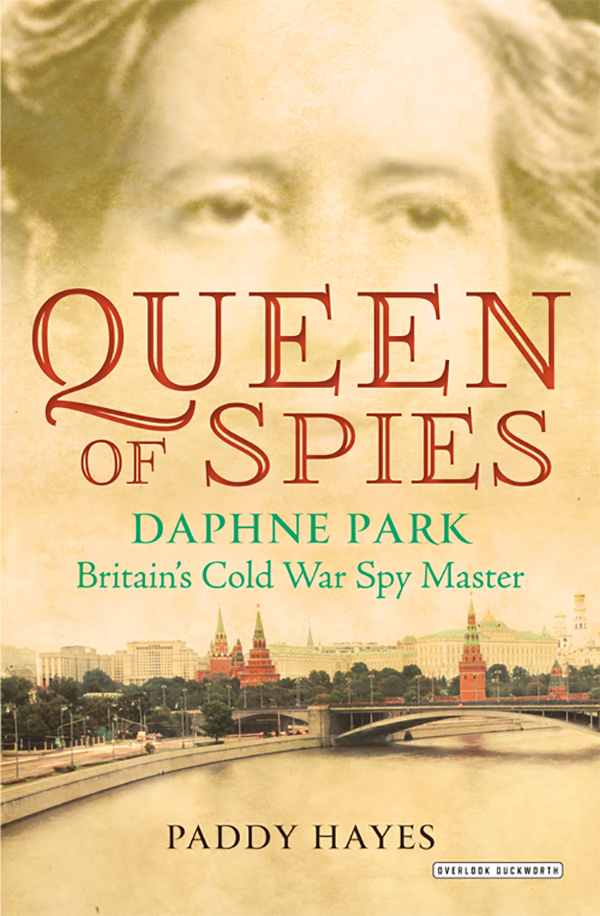This edition first published in hardcover in the United States and the United Kingdom in 2016 by Overlook Duckworth, Peter Mayer Publishers, Inc.
NEW YORK
141 Wooster Street
New York, NY 10012
www.overlookpress.com
For bulk and special sales please contact ,
or to write us at the above address.
LONDON
30 Calvin Street
London E1 6NW
www.ducknet.co.uk
For bulk and special sales please contact ,
or write to us at the above address.
2015 by Paddy Hayes
All rights reserved. No part of this publication may be reproduced, stored in a retrieval system, or transmitted, in any form or by any means, electronic, mechanical, photocopying, recording or otherwise, without the prior permission of the publisher.
ISBN: 978-1-4683-1325-3

DAPHNE PARK
Britains Cold War Spy Master
PADDY HAYES
24 BLACK-AND-WHITE PHOTOGRAPHS
F rom living in a tin-roofed shack north of Dar-es-Salaam to becoming Baroness Park of Monmouth, Daphne Park led a most unusual lifeone that consisted of a lifelong love affair with the world of Britains secret services. In the 1970s, she was appointed to Secret Intelligence Services most senior operational rank as one of its seven Area Controllersan extraordinary achievement for a woman working within this most male-dominated and secretive of organizations.
In Queen of Spies, Paddy Hayes recounts the fascinating story of the evolution of the British Secret Intelligence Service (SIS) from World War II to the Cold War through the eyes of Daphne Park, one of its outstanding and most unusual operatives. He provides the reader with one of the most intimate narratives yet of how the modern SIS actually went about its business whether in Moscow, Hanoi, or the Congo, and shows how Park was able to rise through the ranks of a field that had been comprised almost entirely of men.
Queen of Spies captures all the paranoia, isolation, and deception of Cold War intelligence work, and combines it with the personal story of one extraordinary woman trying to navigate this secretive world. Hayes unveils all that it may be possible to know about the life of one of Britains most celebrated spies.
(between )
| Daphne Park shortly after she arrived in Britain in 1932 |
| Daphne Park around the time she graduated from Somerville College in 1943 |
| Daphne Park in FANY c. 1943 |
| Sir Stewart Menzies, Chief of SIS 1939-52 |
| Commander Kenneth Cohen, Chief Controller/Europe, SIS |
| Dame Professor Lisa Hall, first head of the Joint Services School for Linguistics in Cambridge |
| Sir William Goodenough Hayter, British ambassador to Moscow, 1953-57 |
| Douglas DeWitt Bazata, Parks first lover |
| Bazata with Princess Grace of Monaco |
| Patrice Lumumba, first Prime Minister of the independent Congo |
| Ian Scott, British Ambassador to the Congo, with General Mobutu |
| Daphne Park and SIS colleague Hugo Herbert-Jones |
| Daphne Park in grounds of house |
| Daphne Park seated |
| John Bruce Lockhart, SIS |
| Daphne Park in Lusaka, the spy in action with customary drink in hand |
| The Grand Kremlin Palace from the roof of the British Embassy |
| Broadway Buildings (today), home of SIS from the mid-1920s to the 1960s |
| Century House (Gloom Hall), SISs headquarters from 1964 to 1994 |
| The joint SIS/CIA team responsible for handling Oleg Penkovsky |
| GRU Colonel Oleg Vladimirovich Penkovsky, agent HERO |
| Typical street scene in Hanoi c. 1980 |
| Spy Station Ulaanbaatar |
| Baroness Daphne Margaret Sybil Desire Park |
This book is dedicated to the memory of
The Major, Commandant Paddy Keogh
(1949-2014)
Take the Hill.
In the following pages you will be introduced to the life story of an extraordinary woman, the British Cold War spy Daphne Park. Her story would be outstanding in any era, but in the context of the times she lived through it is almost beyond imagining. Born into penury in 1921, Daphne Park went from living in a tin-roofed shack five hundred miles up-country from Dar-es-Salaam to becoming, in 1990, Baroness Park of Monmouth. She went from being semi-literate, studying on a plank balanced on two empty kerosene cans, to graduating from Oxford University with an honours degree and being invited back thirty-seven years later to become the Principal of her Oxford college. She went from humble wartime volunteer in 1943 to Area Controller of the Secret Intelligence Service (SIS/MI6) in 1975.
To achieve any of the three would seem like a life fulfilled, ambition satisfied. But to achieve all three speaks of ability, inner strength, determination and certainty of purpose. When so much of her life took place against the backdrop of the Cold War and of Britains slow and often painful disengagement from Empire, it makes for a compelling story, a life well worth the telling.
This is the first biography of a Cold War SIS career officer in thirty years and one of only two or three ever published (books on the betrayers, Philby, Blake etc., excluded). That is testimony, not to any lack of reader interest, but to SISs determination to keep secret what happens within its portals. Current and former members are warned in the sternest terms of their lifetime duty in this regard. Those who ignore the rule face sanctions ranging from exclusion from the SIS family at the lower end of the scale to the loss of pension rights and possible prosecution under the Official Secrets Acts at the higher end. Fortunately, for you the reader (and for me the writer) not all chose to obey that stricture. The score or so SIS officers who cooperated with me in the writing of Queen of Spies did so because they agreed with a former SIS Chief, who on being apprised of my intention to write Daphnes biography remarked, Good, Daphne deserves a decent book. Hers is a story that the Chief felt should be told and that I and my co-operators believe can be told without causing irreparable harm to the current and future operations of Britains intelligence services. I am deeply grateful to those who shared their experiences of Daphne and of SIS with me. You made the book possible.
Like any spy writer I relish any opportunity to reveal secrets, to bring hitherto undisclosed intelligence operations into the light of day, to identity practitioners of the dark arts of espionage, to reveal the tricks of the trade. I am also conscious that with the right to publish goes an obligation of responsibility. No serving SIS officers are personally identifiable through these pages and those former officers who are named (and who are still living) are long since retired and well out of the game. Of course another reason why any bureaucracy likes to operate in secrecy is because that way its mistakes remain in house and do not become subject to public scrutiny. SIS is no different in that regard and readers will find some of what is revealed in these pages makes for uncomfortable reading.
I met Daphne Park following an interview she gave to the BBCs Panorama television programme as part of the intelligence agencies process of coming out (avowal) following the end of the Cold War, whereby for the first time both the Secret Intelligence Service (SIS/MI6) and the Security Service (MI5) were established by statute. I was of course well aware of Park, for she had managed, despite her devotion to secrecy, to become known within circles as an intelligence operative following her involvement in the overthrow of the Lumumba regime in the then newly independent former Belgian Congo.




















